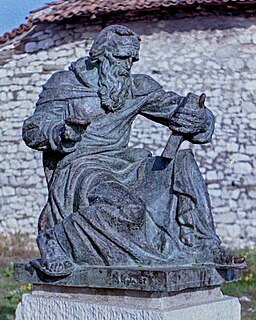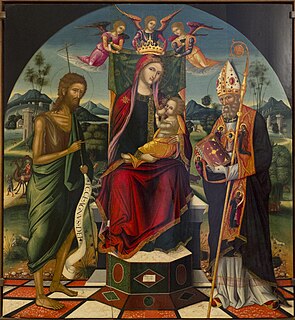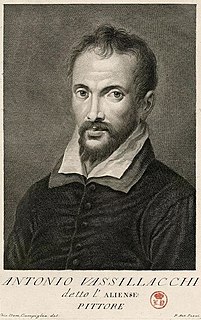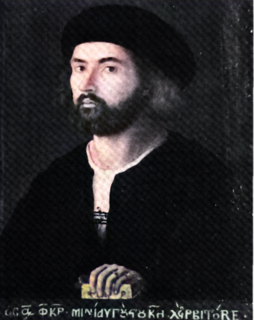 W
WMarco Basaiti was a Renaissance painter who worked mainly in Venice and was a contemporary of Giovanni Bellini and Cima da Conegliano. He has been referred to by several names including Marco Baxaiti, Marcus Basitus, and Marcus Baxiti. There is little documentation on Marco Basaiti besides his painting signatures and a guild's ledger of 1530 ithat records him as a painter of figures.
 W
WBelisario Corenzio was a Greek-Italian painter, active in Venice and Naples. He is one of few Greek painters that did not belong to the Cretan Renaissance like his contemporaries of the time. He escaped the maniera greca completely. He adopted the Venetian style. Other similar Greek painters were Marco Basaiti, Ioannis Permeniates, Antonio Vassilacchi and El Greco. He was sometimes referred to as Il Greco. His teacher was prominent Venetian painter Tintoretto. In 1590, at age 32 Corenzio settled in Naples. Corenzio was influenced by Cavalier d'Arpino. He continued to flourish in the region. His apprentices included: Luigi Rodriguez, Andrea di Leone, Onofrio De Lione and Massimo Stanzione. Corenzio painted many frescos that survived today. Some of his works are in the Church of San Severino and Certosa di San Martino. His style resembles Caravaggio. An Italian legend in Naples exists involving Corenzio, Spanish painter Jusepe de Ribera, and Battistello Caracciolo. They were referred to as the Cabal of Naples. The three painters were rumored to have poisoned their competition for painting contracts. The rumors lack documented evidence. The three painters were very popular in Naples. Corenzio frescoed the Crypt that holds the remains of Matthew the Apostle at Salerno Cathedral and it depicts scenes from the Gospel of Matthew. Corenzio was one of the most celebrated fresco painters in Naples during his time. His drawings can be found all over the world namely at the Metropolitan Museum, Museo di Capodimonte and Louvre.
 W
WMichael Damaskenos or Michail Damaskenos was a leading post-Byzantine Cretan painter. He is a major representative of the Cretan School of painting that flourished in the 16th and 17th centuries. Painters Georgios Klontzas and Damaskenos were major contributors to the Cretan School during the same period. Damaskinos traveled all over the Venetian Empire painting. He remained loyal to his Greek roots stylistically but incorporated some Italian elements in his work. He was strongly influenced by the Venetian school. He painted parts of the Cathedral of San Giorgio dei Greci. Damaskenos has 100 known works. He influenced the works of Theodore Poulakis.
 W
WEmmanuel Lampardos, also known as Emmanouil Lampardos and Manolitzis. He was a Cretan Renaissance painter. Emmanuel and his nephew Emmanuel Lampardos have been very difficult to distinguish because they were active painters around the same period. Countless Greek and Italian artists emulated the famous painters. The name Lampardos was very notable in reference to Cretan art. The family was affiliated with famous painters Franghias Kavertzas and Tzortzi Papadopoulo. Lampardos emulated Georgios Klontzas, Michael Damaskinos, Angelos Akotantos, Andreas Pavias, Andreas Ritzos and Nikolaos Tzafouris. His style was the typical maniera greca with a strong Venetian influence. Countless images of the virgin and child have survived. Lampardos influenced Franghias Kavertzas, Emmanuel Tzanes, Philotheos Skoufos Elias Moskos, Leos Moskos, Ioannis Moskos and Emmanuel Tzanfournaris. Over fifty-six icons have been attributed to Lampardos.
 W
WEmmanuel Tzanfournaris, also known as Emmanouil Manos was a Greek painter. He was a painter in Corfu and Venice. He was taught by famous painter Thomas Bathas. Emmanuel's father Georgios was also a famous painter. Emmanuel was active within the Greek Community of Venice until 1625. Some of his paintings are in the church of San Giorgio dei Greci. He was influenced by Michael Damaskinos and other Venetian painters. Tzanfournaris adopted the Venetian school but also stayed loyal to the maniera greca. He influenced the works of countless painters namely Emmanuel Tzanes, Franghias Kavertzas, Philotheos Skoufos and his son Theofilakto Tzanfournaris. Tzanfournaris artwork can be found all over the world. Sixteen of his paintings have survived.
 W
WEuphrosynos was a Greek Renaissance painter. He was a priest and influenced by Byzantine art and the early Cretan School. Five of his works have survived, all of them in Greece. His technique resembled the works of Andreas Pavias, Angelos Akotantos, and Andreas Ritzos. Euphrosynos may have been a member of the prominent Klontzas family. His paintings of the Virgin Mary and Jesus are typical Cretan School paintings. His Jesus painting resembles Pavias's painting Christ Pantocrator. All of his works are at Mount Athos in the Dionysiou Monastery. They decorate the iconostasis. Fragkos Katelanos and Theophanes the Cretan were also working at Mount Athos around the same period.
 W
WFragkos Katelanos was a Greek painter. He specialized in icon and fresco-painting. His work resembles the Byzantine style of painting with attributes of the Cretan School. His work coincided with Theophanes the Cretan geographically and chronologically. His frescoes can be found in different parts of Greece. His signed work can be found at the Monastery of Great Lavra at Mount Athos. He is one of few Greek artists that were not associated with Venice or Crete. He mainly worked out of Ioannina. He was very popular during his time. Theophanes the Cretan was also associated with Mount Athos but he traveled back to Crete. He also spread the Cretan School to mainland Greece. Both Theophanes the Cretan, Katelanos influenced famous artist Dionysius of Fourna. Katelanos's frescos can be found all over Greece, including at Kozani, Ioannina, Kastoria and the Monastery of Varlaam in Meteora.
 W
WGiovanni Kyprios, also known as Zuane Ciprioto and Ioannis Kyprios. He was a Greek painter from Cyprus living in Venice. Other Greek painters living in Venice around the same period were Thomas Bathas and Emmanuel Tzanfournaris. Kyprios was active during the second part of the 16th century. He was associated with famous painter Tintoretto. Kyprios painted in the traditional Byzantine style. He mixed the traditional Byzantine style with Venetian painting. His work was also influenced by the Cretan artists namely Michael Damaskinos. According to the Institute of Neohellenic Research, eight paintings are attributed to Kyprios. His most notable work is the Dome at San Giorgio dei Greci.
 W
WDomḗnikos Theotokópoulos, most widely known as El Greco, was a Greek painter, sculptor and architect of the Spanish Renaissance. "El Greco" was a nickname, and the artist normally signed his paintings with his full birth name in Greek letters, Δομήνικος Θεοτοκόπουλος, often adding the word Κρής, which means Cretan.
 W
WΙoannis Apakas, also known as Johann Apakass was a Greek painter and priest. He was active in the latter part of the 16th century to the early 17th century. He was popular artist during his time.
 W
WGeorgios Klontzas also known as George Klontzas and Zorzi Cloza dito Cristianopullo. He was a scholar, painter, and manuscript illuminator. He is one of the most influential artists of the post-Byzantine period. He defined the Cretan Renaissance. He worked for both Catholic and Orthodox patrons. His artistic output included: icons, miniatures, triptychs, and illuminated manuscripts. He is known for occupying his icons with countless figures. The technique is extremely complex and unique to Klontzas. Andreas Pavias attempted this technique in the Crucifixion of Jesus. Klontzas's painting All Creation rejoices in thee is his most popular work. Klontzas influenced Theodore Poulakis he created an extremely similar painting called In Thee Rejoiceth. Klontzas's work is strongly influenced by the Venetian school. His triptychs strongly resemble the works of Gentile da Fabriano, namely the Intercession Altarpiece. Klontzas's Last Judgement resembles Michelangelo's Last Judgement in the Sistine Chapel. There are very close similarities. There is no indication that Klontzas saw the work but it is a possibility. According to the Institute of Neohellenic Research fifty-four items of his art exist today.
 W
WMarkos Bathas was a painter, copper engraver, and writer. He was a prominent member of the Strelitzas-Bathas family. He may have been related to famous painters Theophanes Bathas and Thomas Bathas. Markos moved to Venice. He was the first Greek painter associated with San Giorgio dei Greci. Greek painter Michael Damaskinos was also in Venice during the 1560s. He follows the traditional maniera greca. He became a prominent member of the Greek community in Venice. Not much of his works survived. His icons can be found in Ioannina. He was an illustrator, he wrote some of the works of Plotinus. He created the works in an Italian-style text. He also created works with mythological themes.
 W
WMichele Greco da Valona, also known as Michael the Greek from Vlora. He was a Greek painter from Vlorë, Albania. Other prominent Greek painters around the same period were Ioannis Permeniates and Markos Bathas. Other notable Greek-Albanian painters were Marco Basaiti and Onufri. Michele represented the Adriatic renaissance. His art was similar to the style of Nicolaus Filantropinó, Fra Angelico, Paolo Uccello, Carlo Crivelli and Vincenzo de Rogata. Several of his works survived. His most notable work is a controversial triptych featuring the Virgin Mary breastfeeding the people.
 W
WNicholas Ritzos also known as Rizo and Ricio). He was a Greek Renaissance painter. His father was famous painter Andreas Ritzos. His brother was painter Thomas Ritzos. His son was painter Manea Ritzos. Nicholas and his father Andreas Ritzos are the forefathers of the Cretan School of painting. They influenced countless artists both Greek and Italian. There painting style was the typical Venetian influenced maniera greca in Crete. The island transitioned from the classical Byzantine painting to a more refined style. His contemporaries were Andreas Pavias, Nikolaos Tzafouris, and Angelos Akotantos. They influenced painters such as Michael Damaskinos, Petros Lambardos, and Emmanuel Lambardos. Nine of his works have survived.
 W
WOnufri Argitis or Onoufrios of Neokastro or Onoufrios Argytes was a 16th century painter of Orthodox icons and Archpriest of Elbasan, active in the 16th century in modern-day southern Albania and in the south-western region of Macedonia. His works are characterized by post-Byzantine and Venetian influences. He also painted portraits, landscapes, and churches.
 W
WIeremias Palladas, also known as Pouladas Ieremia Pallada. He was a Greek Renaissance painter. He was a clergyman, painter, and educator. He was affiliated with Saint Catherine's Monastery in Mount Sinai, Egypt. He is one of the most notable Greek painters of the 17th century. His family consisted of clergy and painters. His nephew was Patriarch of Alexandria Gerasimos Palladas. His work was influenced by Nikolaos Tzafouris and Angelos Akotantos. Georgios Klontzas and Emmanuel Lambardos were active in Crete around the same period. Palladas influenced the works of Theocharis Silvestros, Iakovos Moskos, Ioannis Kornaros and Philotheos Skoufos. According to the Institute of Neohellenic Research, twenty-four of his works survived. His specialty was painting crosses for the iconostasis or templo. Most of his works are in Egypt.
 W
WAndreas Pavias was a Greek painter and educator. He was a representative of the Cretan School. His teacher was Angelos Akotantos. He was affiliated with Andreas Ritzos. His style began to incorporate the Venetian school. He experimented with different techniques. He is one of the founding fathers of the Cretan School. Angelos Pitzamanos was his student for five years. His works influenced countless artists both Italian and Greek. His paintings were in many churches and private collections in both geographic areas. He also influenced the works of other artists of the Cretan School namely Theodore Poulakis, Georgios Klontzas, Michael Damaskenos and many others. His most famous work is the Crucifixion of Jesus. Seven of his works survive today, six bear his signature.
 W
WIoannis Permeniates also known as Giovanni Permeniate, Joannes Permeniates and, Zuan Permeniatis. He was a Greek painter in Venice active during the early 16th century. His most popular painting is The Virgin and Child Enthroned. He was a Greek icon painter who attempted to escape the maniera greca. His icons exhibit qualities of both Venetian and Cretan styles. Exhibiting a more refined maniera greca, he eschews the simplicity of Duccio and Cimabue, and adds more space to his paintings.
 W
WPetros Lambardos, also known as Petro Lambardou or Petrus Lambardo. He was a Greek Renaissance painter from Crete. One of the earliest recorded members of the Lambardos family of painters. He comes from a famous family of painters from the island of Crete. Similar to the Bathas, Moskos, and Tzanes family. The family had many notable painters. Emmanuel Lambardos has the largest catalog of works. Two other notable painters of the same last name were Ioannis and Tzortzi Lambardos. The family were major contributors to the Cretan painting style. Three of Petros's paintings survived. The Virgin Mary painting is in Cyprus, Christ the High Priest is at the Benaki Museum and John the Baptist is in Palermo, Italy.
 W
WAngelos Pitzamanos (1467–1535) was a Greek Renaissance painter. The artists is sometimes referred to as Angelos Bitzamanos. He was born in Crete and migrated to Otranto, Southern Italy where he did most of his work. A contract between Andreas Pavias and Pitzamanos illustrates that Pitzamanos was his apprentice. Angelos was a student of Andreas Pavias for five years (1482-1487). It is evident that his work featured both the Greek style and Italian style of the time. Pitzamanos later became a famous master.
 W
WTheophanis Strelitzas, also known as Theophanes the Cretan pronounced Theophanes O Krees or Theophanes Bathas. He was a Greek painter and educator. He painted icons and frescos. He was a member of a prominent family of painters Strelitzas-Bathas. The origin of the family was the Peloponnesus region. His son was famous painter Symeon Bathas Strelitzas. He was also his apprentice. Other important painters of the same name were Thomas Bathas and Markos Bathas. Another fresco painter of the same period was Fragkos Katelanos. Theophanes's family built the framework of the Cretan School. Over one hundred icons and frescos have survived. They can be found all over Greece. Theophanes influenced countless painters. Some of the painters were Fragkos Katelanos and Dionysius of Fourna. He was one of the most important fresco painters of the period.
 W
WJorge Manuel Theotocópuli was a Greek-Spanish painter and architect. He was the only son of the iconic painter, Doménikos Theotokópoulos, called "El Greco".
 W
WThomas Bathas was a Greek painter, educator, and Vikar. He employed the maniera greca on some of his work but he also broke from tradition employing the Venetian style. He traveled around the Venetian Empire going from Heraklion to Corfu and Venice. He was a prominent member of the Greek Confraternity in Venice. He was friends with Gabriel Severus, Metropolitan of Philadelphia. He was very popular among both Greek and Italian patrons. He influenced the works of countless artists both Italian and Greek. Some of his works are in San Giorgio dei Greci and the Hellenic Institute of Venice. Emmanuel Tzanes, Konstantinos Tzanes, Ioannis Moskos, and Philotheos Skoufos were some Greek artists influenced by his work. One of his students was famous painter Emmanuel Tzanfournaris. He left him a fortune in his will. His most famous works include: Portrait of the Metropolitan of Philadelphia Gabriel Severus and Virgin and Child Enthroned. Twenty of his paintings have survived.
 W
WAntonio Vassilacchi, also called L'Aliense, was a Greek painter, who was active mostly in Venice and the Veneto.
 W
WVictor was a Greek painter in Venice active during the middle part of the 16th century. The only surviving painting is his self portrait. He was a painter during the High Renaissance. He drastically escaped the maniera greca. He is comparable to Ioannis Permeniates.